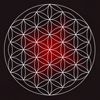|
Flower of Life
A geometrical figure, that is composed of multiple
evenly-spaced, overlapping circles of the same diameter, that are arranged in a
six-fold symmetry, with the centre of each circle being on the border of six
surrounding circles, creating a flower-like pattern. It is deemed by some to
depict the fundamental forms of space and time, and in three-dimensional form it
is associated with the figure of a tube torus, which is described as the form
that the flow of energy takes at every scale of existence. The torus' dynamic,
i.e. the primary pattern of balanced energy that flows around its skeleton
structure, the vector equilibrium –a perfectly balanced force field in the shape
of a cuboctahedron, i.e. a cube with 8 triangular and 6 square faces, which has
12 equal energy lines radiating out, that stabilize its centre like the 12
spokes of a wheel, and that form the outlines of 8 triangular pyramids (tetrahedrons),
as well as 6 square based pyramids–, are said to be the primary patterns
fundamental to the creation of the universe at all scales, creating energy
without combustion. There are many spiritual beliefs associated with this
figure, especially a version made up of a total of 64 circles and semi-circles, that can be found in the art of cultures from all over the world, from
the rust coloured whirlpool designs painted on
Ban Chiang-style pottery (fig.)
to the sphere or ball with a flower-like pattern under the right front paw of the
male
Rui Shi
or
Imperial Guardian Lion at the
Forbidden City in
China (fig.).
The latter is also associated with a larger scale of the vector equilibrium,
with a total of 64 pyramids known as tetrahedra, that
radiate outward from the centre and which –if replaced by spheres that represent
the torus' force fields that surround each of the pyramids– would result in a
perfect template of the ball, or if flattened out, an exact overlay on the
pattern of the Flower of Life as found in other cultures. Some even believe that the 64 energy units
in the sphere are
associated with the 64 hexagrams used in the
I
Ching, as the six lines of each symbol could be set together
to form the six edges of a tetrahedron, together forming
exactly 64 tetrahedra. Curiously, this pattern of 64 is repeatedly found encoded
in ancient art forms from around the world, as well as in the 64 codons of DNA.
Some of the designs found in art and architecture are very similar, but are no
more than a look-alike pattern, not made up of overlapping circles (fig.).
回






|

